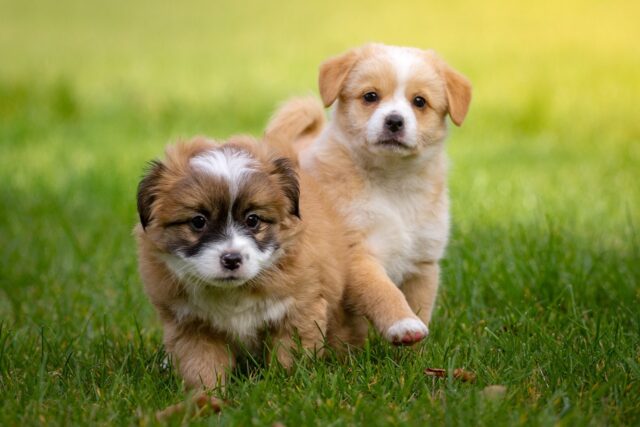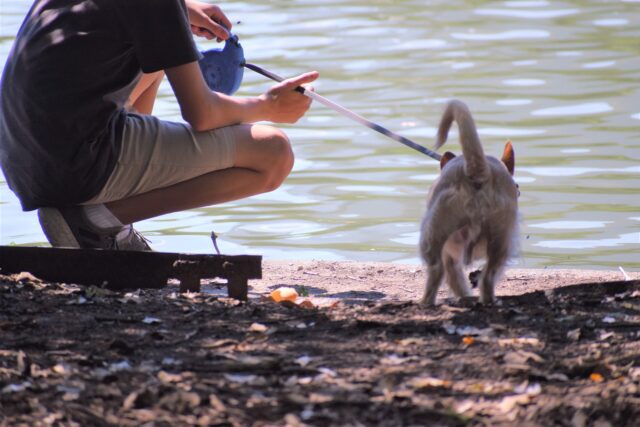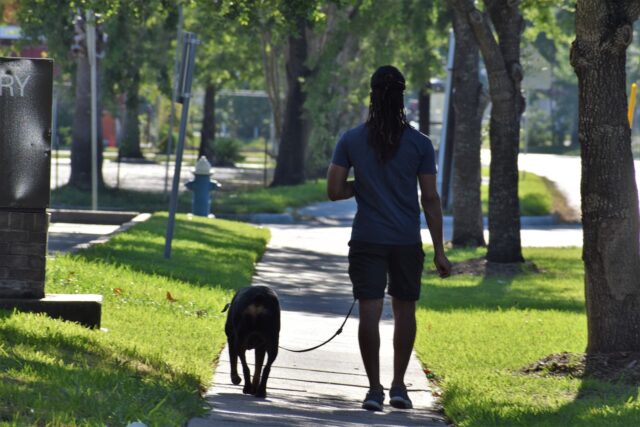Many of us turn to pee pads for housetraining our pups, and although these may seem ideal for potty training, they can make potty training take longer if training is not done correctly. Puppy pads are also helpful when pups are too young to go outdoors because they’re not fully vaccinated. VCA Animal Hospital says learning to go potty in appropriate places is essential for all pups and adult dogs.
“Select an appropriate toileting area outdoors and, when you bring your puppy to the elimination area, always lead your puppy through the same exit door,” says VCA.
The AVMA explains that you should try to notice signals, such as sniffing and circling, as cues that your puppy needs to go outdoors. If you’re using pee pads, you only occasionally have the chance to supervise and reward. You also may become lazy and not get to work on a schedule and allow for consistency, which makes it much harder to potty train.
There are also other reasons why you should not use pee pads for dogs. Potty pads teach your dog to go potty on anything rectangular in shape in your home, from bathroom mats to kitchen rugs, and may be confusing to dogs unless dogs are taught correctly.
Pee pads for pups may seem ideal when potty training puppies, but many positive dog trainers say this happens when you use potty pads and not the outdoors for potty training. Here’s the takeaway:
1. Complicates Potty Training
Potty training pups doesn’t mean you should resort to only using puppy pee pads. Often, pet parents using potty training pads for dogs become lazy with housetraining and forgo scheduled outdoor walks and potty training sessions. You need to decide from day one what your ideal plans for your puppy regarding potty training are.
“That’s because toilet training a puppy is largely a matter of teaching surface and location preferences for toileting. Puppies (and the dogs they grow up to be) learn what surfaces to urinate or defecate on (and which ones not to) based on the practice you’re about to give your pup now,” explains Victoria Stilwell.
Pee pads can confuse your new puppy and make it harder to understand where they should go potty outdoors. They may think any rectangular surface is an acceptable spot to relieve themselves, leading to rugs, mats, and furniture accidents.
In addition, constantly switching between pee pads and outdoor potty training can confuse your pup and slow the progress of housetraining. Establishing a consistent routine and outdoor space for your puppy or adult dog to do their business is essential; pee pads can disrupt this process.
2. Creates Unsanitary Living Conditions
While using puppy pee pads may seem convenient for avoiding accidents in the house, they can also create unsanitary living conditions for you and your pup. Pee pads can quickly become soiled and dirty, breeding ground for bacteria and unpleasant odors.
In addition, constantly changing and disposing of pee pads can be time-consuming and expensive, not to mention the environmental impact of using disposable products daily. By ditching pee pads, you can promote a cleaner and more environmentally friendly living space for you and your furry friend.
3. Impacts Potty Training Progress
Pee pads for puppies can confuse your puppy and disrupt potty training. Consistency is key when successfully housetraining your pup; constantly switching between indoor and outdoor potty options can disrupt this progress.VCA Animal Hospital explains that it takes time for puppies to grow up and hold their eliminations and that it can take even longer for them to show you that they need to go potty.
Accidents are more likely when your dog is confused about where to go potty. This not only sets back the progress of housetraining, but it can also create a frustrating and stressful environment for you and your pup. Look for signs your puppy needs to go, like squatting, circling, and sniffing, and then head outdoors quickly with your puppy.“Puppies often become restless when their bladders or bowels are full. If you see these signs, calmly but quickly lead your dog to the appropriate toileting area,” says VCA. Sticking to a consistent outdoor potty routine and eliminating pee pads can help your dog learn where and when to go potty.
4. The Right Way to Potty Train Your Puppy
Additional Tips for Potty Training Your Puppy
- Establish a consistent potty schedule
- Use positive reinforcement techniques
- Avoid punishing or scolding for accidents
- Monitor food and water intake to predict potty needs
- Patience and consistency are essential in successful potty training
- Remember to also provide love, exercise, and proper training in all areas of
First and foremost, consistency is key. Establish a routine for your pup’s potty breaks, including specific times and locations. This will help your dog learn where and when to go potty. Additionally, positive reinforcement is crucial. When your puppy successfully goes potty outside, praise it and give it a treat. This will reinforce the behavior and encourage it to continue going potty in the designated outdoor area. On the other hand, if accidents happen indoors, do not punish or scold your pup. This can create fear and confusion, hindering their potty training progress. Instead, clean up the accident and continue with your routine.
Another tip is to monitor your puppy’s water and food intake closely. This will give you an idea of when they may need to go potty and can help prevent accidents. Lastly, be patient and consistent. Potty training takes time, and every puppy learns at their own pace. Stay positive and consistent with your approach; your pup will eventually know where and when to go potty. With these tips, you can train your puppy to go potty outside without using pee pads. This not only promotes good bathroom habits for your pup, but it also creates a happier and less stressful environment for both you and your furry friend.
Other Aspects of Raising a Happy and Well-Behaved Puppy
- Socialization with other dogs and people
- Obedience training
- Proper nutrition and exercise
- Regular grooming and veterinary care
- Creating a safe and comfortable living environment
- Understanding and addressing any behavior issues or concerns
By focusing on all aspects of puppy care, you can create a happy and well-adjusted pup who will bring joy to your life for years. Remember, patience and consistency are essential in puppy training and care areas.
FAQ’s Puppy Training Pads for Indoors
Do training pads work for puppies?
Many experts say dog pee pads can confuse puppies and make housetraining more difficult. Taking dogs outside on a regular potty training schedule helps with potty training and sets you up for success. That said, puppy pads are a must-have if you live in an apartment building.
But here’s the thing—you can also use puppy grass pads to help you. Pups associate grass pads with the outdoors, whereas with puppy pads, some pups get used to potty on rectangular-shaped rugs, bath mats, etc.
What age should a puppy be pad trained?
Pups can start training on puppy pads when they are brought home. Although puppy pads give pups and senior dogs an absorbent surface to pee on, they definitely make potty training more confusing for puppies and young dogs. If you can take your puppy outdoors regularly, there’s no reason to use puppy pee pads.
How do you attract a puppy to pee on a pad?
When your puppy relieves himself on the puppy pad, you should praise and reward him. The American Kennel Club (AKC) says having your dog go outside is ideal, but potty pads can sometimes help with successful potty training.
Teaching a puppy to use a puppy pee pad means being consistent and initially setting out with potty breaks every 15 minutes.
” How often will depend on his age and bladder strength. For very young puppies, it could be as often as every 15 minutes. Better a wasted trip than an accident,” says the AKC.
Do puppy pads make it harder to potty train?
” Dogs repeat behaviors that are rewarding, and doing their business in the right spot is no different. If you reward your puppy with praise and treats whenever he uses his potty pad, he will be more likely to use it again in the future,” explains the AKC.
AKC explains that when it’s time to transition from the indoors to the outdoors when your pup’s vaccinated, you should take your puppy outdoors instead of to his pee pad. You can also briefly move the pee pad outdoors daily to understand your puppy. The AKC also says that you should decrease the size of the potty pad once it’s outdoors until your puppy uses the ground instead.
How to Puppy Train Your New Dog
https://www.youtube.com/watch?v=isvrjSe9Nf8
Video Credit: On the Go Frenchies
Final Thoughts
Finding the right dog breed for your family is just the beginning of a rewarding journey. At Pettito Dallas and Pettito OKC, our pet counselors are here to ensure you have all the support you need, not just in choosing the perfect puppy but throughout your entire journey with your new furry friend.
Our dedicated team goes beyond just matching you with a breed that fits your family’s lifestyle. We offer comprehensive support, including training advice, behavioral tips, and ongoing guidance to help you and your puppy thrive together. From the moment you bring your new companion home, we’re here to assist with any questions or challenges that arise, ensuring a smooth transition and a happy, well-adjusted dog.
Ready to find your ideal family dog and get expert support along the way? Contact Pettito Dallas or Pettito OKC today. Let us help you make the right choice and provide you with the tools and advice you need for a successful and joyful puppy experience. With our guidance, your journey to finding and raising the perfect family dog will be as enjoyable and rewarding as it should be.









